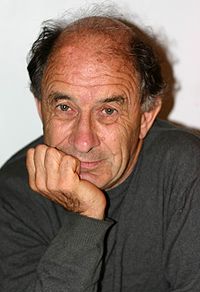V. I. Arnold
| Vladimir Arnold | |
|---|---|

Vladimir Arnold in 2008
|
|
| Born |
12 June 1937 Odessa, Ukrainian SSR, Soviet Union |
| Died | 3 June 2010 (aged 72) Paris, France |
| Nationality | Soviet Union, Russian |
| Alma mater | Moscow State University |
| Known for |
ADE classification Arnold's cat map Arnold conjecture Arnold diffusion Arnold's rouble problem Arnold's spectral sequence Arnold tongue ABC flow Arnold–Givental conjecture Gömböc Gudkov's conjecture Hilbert's thirteenth problem KAM theorem Kolmogorov–Arnold theorem Liouville–Arnold theorem Topological Galois theory |
| Awards |
Shaw Prize (2008) State Prize of the Russian Federation (2007) Wolf Prize (2001) Dannie Heineman Prize for Mathematical Physics (2001) Harvey Prize (1994) RAS Lobachevsky Prize (1992) Crafoord Prize (1982) Lenin Prize (1965) |
| Scientific career | |
| Fields | Mathematics |
| Institutions |
Paris Dauphine University Steklov Institute of Mathematics Independent University of Moscow Moscow State University |
| Doctoral advisor | Andrey Kolmogorov |
| Doctoral students | |
Vladimir Igorevich Arnold (alternative spelling Arnol'd, Russian: Влади́мир И́горевич Арно́льд, 12 June 1937 – 3 June 2010) was a Soviet and Russian mathematician. While he is best known for the Kolmogorov–Arnold–Moser theorem regarding the stability of integrable systems, he made important contributions in several areas including dynamical systems theory, catastrophe theory, topology, algebraic geometry, symplectic geometry, differential equations, classical mechanics, hydrodynamics and singularity theory, including posing the ADE classification problem, since his first main result—the solution of Hilbert's thirteenth problem in 1957 at the age of 19.
Arnold was also known as a popularizer of mathematics. Through his lectures, seminars, and as the author of several textbooks and popular mathematics books, he influenced many mathematicians and physicists. Many of his books were translated into English.
Vladimir Igorevich Arnold was born on 12 June 1937 in Odessa, Soviet Union. His father was Igor Vladimirovich Arnold (1900–1948), a mathematician. His mother was Nina Alexandrovna Arnold (1909–1986, née Isakovich), an art historian. When Arnold was thirteen, an uncle who was an engineer told him about calculus and how it could be used to understand some physical phenomena, this contributed to spark his interest for mathematics, and he started to study by himself the mathematical books his father had left to him, which included some works of Leonhard Euler and Charles Hermite.
...
Wikipedia
